Are you seeking the thrill of exploring Vietnam’s stunning landscapes on foot? What are popular trekking routes and where do you start? SIXT.VN is your gateway to unforgettable trekking adventures, offering expert guidance and convenient travel solutions for discovering hidden gems like Ngu Lam Peak and beyond. From transportation to accommodation, we ensure a seamless journey filled with scenic beauty and cultural immersion. Uncover incredible hiking trails, travel tips, and essential services to make your Vietnam trekking experience extraordinary.
1. Unveiling Vietnam’s Trekking Paradise: Cat Ba National Park
Cat Ba National Park, established in 1986 within Vietnam’s breathtaking Halong Bay, is a sanctuary for hiking enthusiasts worldwide. This natural wonderland boasts unparalleled biodiversity, awe-inspiring scenery, and meticulously maintained trails, creating an unforgettable trekking experience.
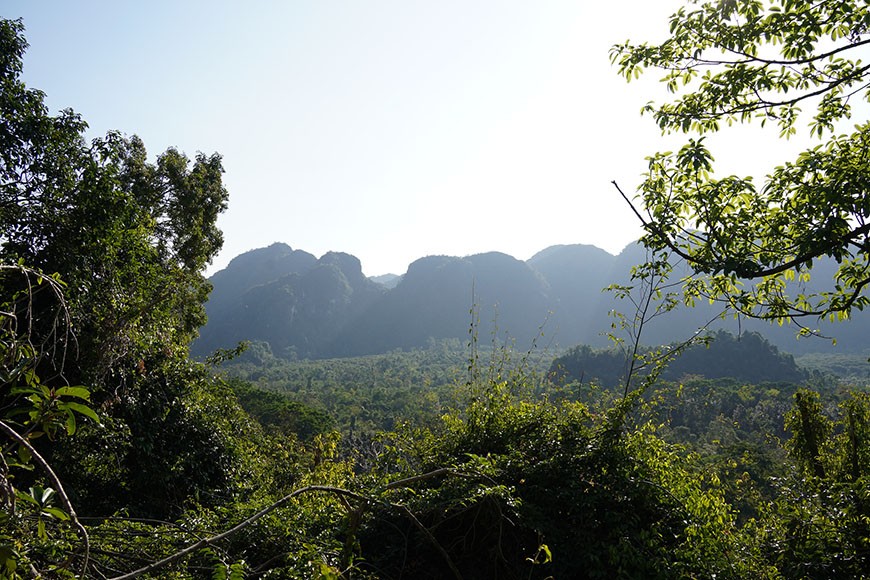 Cat Ba National Park Trekking
Cat Ba National Park Trekking
Cat Ba National Park offers incredible hiking experiences. Photo: Mr. Linh’s Adventures.
1.1 What Makes Trekking in Cat Ba National Park So Appealing?
Cat Ba National Park offers a unique blend of natural beauty, cultural experiences, and adventure, making it a must-visit destination for trekking enthusiasts.
- Biodiversity Hotspot: The park is home to a diverse range of plant and animal species.
- Breathtaking Scenery: From lush hills to limestone cliffs, the park offers stunning panoramic views.
- Well-Maintained Trails: The trails are clearly marked and easy to navigate.
- Cultural Immersion: Interact with local communities and learn about their way of life.
1.2 What Unique Biodiversity Can You Discover While Trekking in Cat Ba?
Cat Ba National Park is a treasure trove of flora and fauna, offering trekkers a chance to observe unique species in their natural habitat.
During your trek, keep an eye out for:
- Monkeys: Playful primates that roam freely in the park.
- Lizards: A variety of reptiles basking in the sun.
- Snakes: Various snake species, some of which are venomous (exercise caution).
- Wild Cats: The park’s elusive emblem, rarely seen but a symbol of its wild nature.
- Birds: Numerous bird species, delighting birdwatchers with their songs and vibrant colors.
According to a study by the Vietnam National Museum of Nature, Cat Ba National Park harbors over 1,500 plant species and 300 animal species (Vietnam National Museum of Nature, 2020), highlighting its significance as a biodiversity hotspot.
1.3 How Does Cat Ba’s Landscape Enhance the Trekking Experience?
Trekking through Cat Ba National Park unveils a tapestry of stunning landscapes, each offering a unique perspective and captivating beauty.
Expect to encounter:
- Lush Green Hills: Rolling hills covered in vibrant vegetation.
- Sheer Limestone Cliffs: Towering cliffs that rise dramatically from the sea.
- Lush Valleys: Fertile valleys teeming with life.
- White Sandy Beaches: Pristine beaches offering a respite from the trek.
The diverse landscapes provide a constantly changing backdrop, ensuring an engaging and visually stimulating trekking experience.
1.4 How Easy Is It to Navigate the Trekking Trails in Cat Ba?
Navigating the trekking trails in Cat Ba National Park is generally straightforward, thanks to well-maintained paths and clear signage.
While there is no official hiking trail map, the trails are typically well-marked, providing guidance along your chosen route. However, it’s always wise to:
- Take a photo of the general map: Refer to it if needed, especially if signs are missing due to weather conditions.
- Consider hiring a local guide: A guide can provide valuable insights and ensure you stay on the right path.
1.5 What Cultural Encounters Await You on Your Trek?
Trekking in Cat Ba National Park offers more than just natural beauty; it provides opportunities to connect with the local culture and experience the Vietnamese way of life.
During your trek, you might encounter:
- Fishermen: Returning from their boats with the day’s catch.
- Villagers: Working in their fields, cultivating rice and other crops.
- Children: Playing in the streets, their laughter filling the air.
Don’t hesitate to engage with the locals, offer a friendly “xin chào” (hello), and learn about their traditions and customs.
2. Planning Your Trek: Location and Accessibility
2.1 Where Exactly Is Cat Ba National Park Located?
Cat Ba National Park spans 280 km2 and is located in Cat Hai district, within the city of Hai Phong in northeastern Vietnam.
Specifically, the park is situated on Cat Ba Island, approximately 20 km east of Hai Phong and immediately west of the renowned Halong Bay. It’s the largest island in this famous bay. The national park extends beyond Cat Ba Island, encompassing smaller islands and marine waters to the east.
2.2 What Is the Landscape Like in Cat Ba National Park?
The landscape of Cat Ba National Park is dominated by karst limestone formations, similar to Halong Bay.
These formations create a dramatic topography characterized by:
- Limestone Islands: Islands rising abruptly from the sea.
- Rugged Terrain: Steep rocky outcrops and challenging slopes.
- Ngu Lam Peak: The highest point in the park, reaching 332 meters above sea level.
2.3 What Kind of Natural Habitats Can Be Found in the Park?
Cat Ba National Park boasts a rich array of natural habitats, supporting a diverse ecosystem.
These habitats include:
- Forested Hills: Lush hills covered in dense forests.
- Freshwater Lakes: Small, serene lakes providing water sources for wildlife.
- Swamp Forests: Freshwater swamp forests adapted to waterlogged conditions.
- Mangroves: Coastal mangrove forests providing vital habitats for marine life.
- Sandy Beaches: Pristine beaches offering relaxation and recreation.
- Coral Reefs: Vibrant coral reefs teeming with marine biodiversity.
2.4 How Do You Get to Cat Ba National Park From Hanoi?
Traveling from Hanoi to Cat Ba National Park is relatively straightforward, with several transportation options available.
A popular and convenient option is to take a direct bus from Hanoi’s Old Quarter to Cat Ba Island.
These buses typically offer:
- Comfortable seating: Ensuring a relaxing journey.
- Air conditioning: Keeping you cool in the Vietnamese heat.
- Bottled water: Staying hydrated during the trip.
- Free Wi-Fi: Staying connected on the go.
The journey typically takes around 3 hours.
2.5 What Are the Transportation Options Once You Reach Hai Phong?
Once you arrive in Hai Phong, you have a couple of options to reach Cat Ba Island.
- Boat from Binh Port: This is the quickest option, taking approximately 45 minutes.
- Private Boat: For a more luxurious experience, consider a private boat departing from Hai Phong or Dinh Vu. Prices vary depending on the boat size and number of passengers.
2.6 Do You Need to Book Transportation in Advance?
It is highly recommended to book your ferry or bus tickets in advance, especially during the peak season (June to August).
Booking ahead ensures you secure your spot and avoid potential delays or disappointment.
2.7 How Do You Get From Cat Ba Town to the National Park Entrance?
The entrance to Cat Ba National Park is located 12 km from the center of Cat Ba town.
You can reach the entrance by:
- Renting a motorcycle: Providing flexibility and independence.
- Renting a bicycle: A more eco-friendly option for those who enjoy cycling.
- Hiring a private car: Offering comfort and convenience, especially for families or groups.
3. When to Go: Choosing the Best Time for Your Trek
3.1 What Is the Climate Like in Cat Ba National Park?
Cat Ba National Park experiences a tropical monsoon climate, influenced by the ocean.
This means:
- Hot Summers: Temperatures can reach 30°C (86°F).
- Mild Winters: Temperatures can drop to around 15-20°C (59-68°F).
3.2 When Is the Ideal Time to Visit Cat Ba for Trekking?
The best time to visit Cat Ba National Park for trekking is from April to November.
During this period, you can expect:
- Dry and sunny weather: Ideal for outdoor activities.
- Pleasant temperatures: Averaging around 25°C (77°F).
If possible, aim for October and November, as these months typically offer the most favorable weather conditions.
3.3 When Should You Avoid Trekking in Cat Ba?
Avoid the rainy season, which runs from November to March.
During this time, the trails can become slippery, and boat trips may be canceled due to inclement weather.
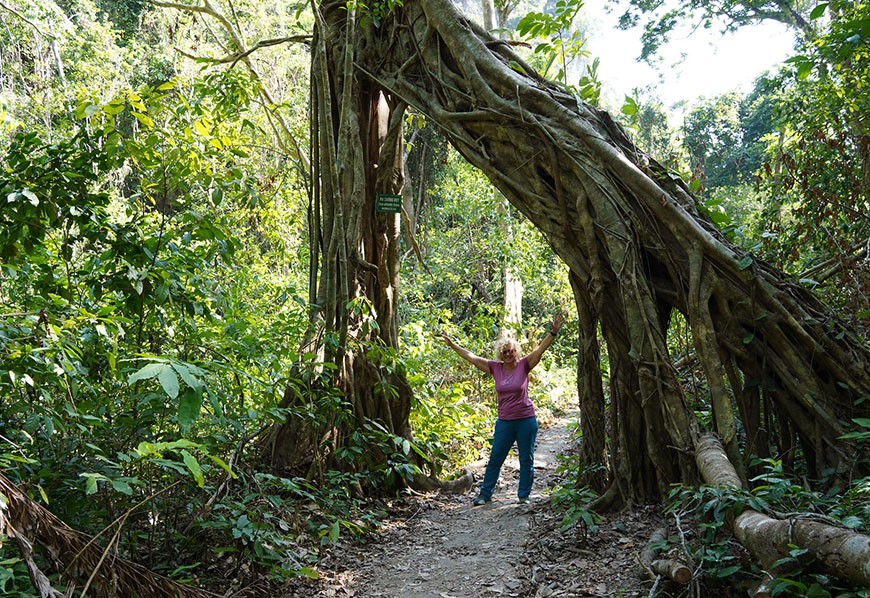 Old Tree in Cat Ba National Park
Old Tree in Cat Ba National Park
A scenic hiking trail in Cat Ba National Park. Photo: Mr. Linh’s Adventures.
4. Accommodation and Gastronomy: Enhancing Your Trekking Experience
4.1 What Accommodation Options Are Available in Cat Ba?
Cat Ba offers a diverse range of accommodation options to suit various budgets and preferences.
You can choose from:
- Beachside bungalows: Offering direct access to the beach and stunning ocean views.
- Luxury hotels: Providing upscale amenities and services.
- Homestays: Offering an authentic cultural experience and a chance to interact with local families.
4.2 What Kind of Culinary Delights Can You Expect in Cat Ba?
Cat Ba invites you to indulge in the flavors of traditional Vietnamese cuisine, with a focus on fresh seafood.
Expect to find dishes based on:
- Fresh seafood: Including fish, shrimp, crab, and squid.
- Rice: A staple of Vietnamese cuisine.
- Noodles: Used in various soups and stir-fried dishes.
4.3 What Local Specialties Should You Try?
Be sure to sample the local specialties, such as:
- Bun tom (shrimp vermicelli): A signature dish of the island, featuring rice vermicelli served in a savory broth with shrimp, vegetables, and peanuts.
- Cua bể nướng (grilled crab): A delicious and flavorful crab dish.
- Chả mực (squid dumplings): A unique and tasty snack.
- Sò Ä‘iệp nÆ°á»ng mỡ hành (grilled scallops with chive butter): A delectable seafood dish.
5. Practical Information: Essential Details for Your Trek
5.1 What Are the Entrance Fees for Cat Ba National Park?
- Entrance fee: 40,000 VND per person.
- Parking fee: 5,000 VND.
5.2 What Are the Opening Hours of the Park?
The park is open from 7:30 a.m. to 5:30 p.m.
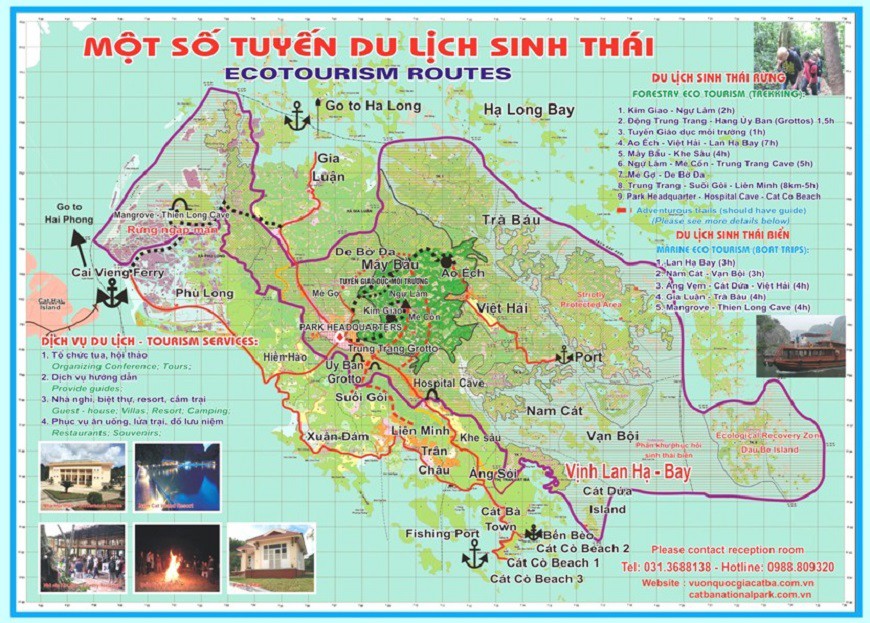 Cat Ba Trekking Trails Map
Cat Ba Trekking Trails Map
A map of the trekking trails in Cat Ba National Park.
6. Hiking Trails in Cat Ba National Park: Exploring the Natural Beauty
6.1 What Are the Main Trekking Routes in Cat Ba National Park?
Cat Ba National Park offers a variety of hiking trails to suit different fitness levels and interests.
The main trekking routes include:
- 18-kilometer hiking trail: This trail takes 4 to 8 hours to complete and is open to walkers.
- Shorter routes: These routes take 2 to 3 hours and allow you to visit the most beautiful sites, such as the frog pond (Ao Ếch) – Việt Hải village.
6.2 What Is the Forestry Education Route?
The first 2.5 km of the 18-kilometer trail is designated as a forestry education route.
On this route, you can:
- Walk: Enjoy a leisurely stroll through the forest.
- Bike: Cycle through the scenic landscape.
- Ride a motorcycle or car: Vehicles with less than 16 seats are permitted.
6.3 What Are the Highlights Along the Forestry Education Route?
The forestry education route takes you through:
- Mây Bầu and Áng Phay peaks: Offering beautiful views of the lagoon.
- Primary forest: Allowing you to immerse yourself in the lush vegetation.
- Flooded forest in the limestone valley: Located 80 meters above sea level.
6.4 What Is the Frog Pond (Ao Ếch)?
The frog pond, also known as Ao Ếch, is a 3.2-hectare pond teeming with life.
Here, you can:
- Listen to the croaking of thousands of frogs: Creating a unique soundscape.
- Observe various species of fish and crabs: Thriving in the clear water.
- Relax and have a meal: Enjoying the tranquil surroundings.
6.5 What Is Viet Hai Village Like?
Viet Hai is a picturesque village located 4 km from the frog pond.
In this village, you can:
- Meet the locals: Interacting with the friendly villagers.
- Experience the verdant setting: Enjoying the peaceful atmosphere away from the tourist crowds.
7. Popular Hiking Itineraries: Tailoring Your Trek to Your Preferences
7.1 What Is the Kim Giao Forest to Ngu Lam Peak Trail?
This is the shortest of the routes, suitable for all fitness levels, including children.
This trail takes you through:
- Kim Giao forest: Home to rare, endangered, and ancient Kim Giao trees.
- Ngu Lam Peak: Offering spectacular views over the region.
The hiking route takes about 30 minutes each way.
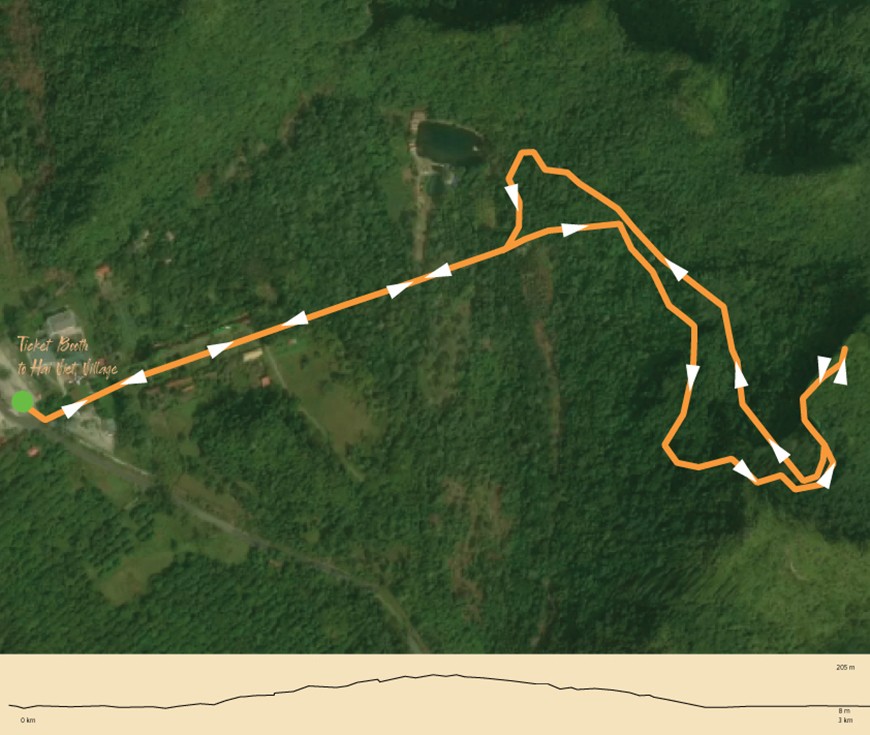 Hiking to Ngu Lam Peak
Hiking to Ngu Lam Peak
Hiking to Ngu Lam Peak provides stunning views. Photo: Mr. Linh’s Adventures.
7.2 What Is the Ao Ech to Viet Hai Village Trail?
This is a challenging trekking route that allows you to explore the ecosystem and wildlife resources of Cat Ba National Park.
This trail takes you to:
- Ao Ech (Frog Lake): Cat Ba’s largest freshwater lake, with crystal-clear water.
- Viet Hai Village: A picturesque fishing village where you can discover the local culture.
- Lan Ha Bay: After the hike, you can take a boat to explore the spectacular islands and hidden beaches of Lan Ha Bay.
7.3 What Is the Kim Giao via Moi Con to Tung Di Trail?
This trail is recommended for people in good physical condition, as the trails are sometimes difficult and slippery.
7.4 What Is the Park Ranger Station – Ao Ech Trail?
This trail starts near the national park headquarters and offers a tough challenge.
You’ll visit:
- A magnificent flooded willow forest: Located in a valley above sea level.
- The largest concentration of freshwater on the island.
The itinerary takes around 4 hours to complete.
7.5 What Are Some Other Trails to Discover?
- Ngu Lam loop: This moderate 4.4-km loop offers a variety of landscapes, from tropical forests to karst rock formations.
- Trung Trang Cave: This easy 1.5 km trail (approx. 1 hour’s walk) leads to Trung Trang cave, a spectacular karst cave.
8. Tips and Other Activities in Cat Ba: Making the Most of Your Visit
8.1 What Are Some Essential Tips for Trekking in Cat Ba?
- Start early: Begin your hike early in the morning to avoid the heat and take advantage of cooler temperatures.
- Wear appropriate clothing: Wear comfortable hiking boots and weather-appropriate clothing.
- Bring a map: Take a photo of the main map and carry enough water for your hikes.
- Respect the environment: Leave no trace of your passage.
8.2 What Other Activities Can You Enjoy in Cat Ba Besides Trekking?
Cat Ba offers a wide range of activities to complement your trekking experience.
Consider trying:
- Kayaking: Exploring the stunning bays and lagoons.
- Swimming: Relaxing on the pristine beaches.
- Climbing: Challenging yourself on the limestone cliffs.
- Caving: Discovering the hidden wonders of the caves.
- Visiting floating villages: Learning about the unique way of life of the local communities.
- Relaxing on Cat Ba’s beaches: Enjoying the sun and sand on Monkey Island, Cat Ong Island, or Prince Island.
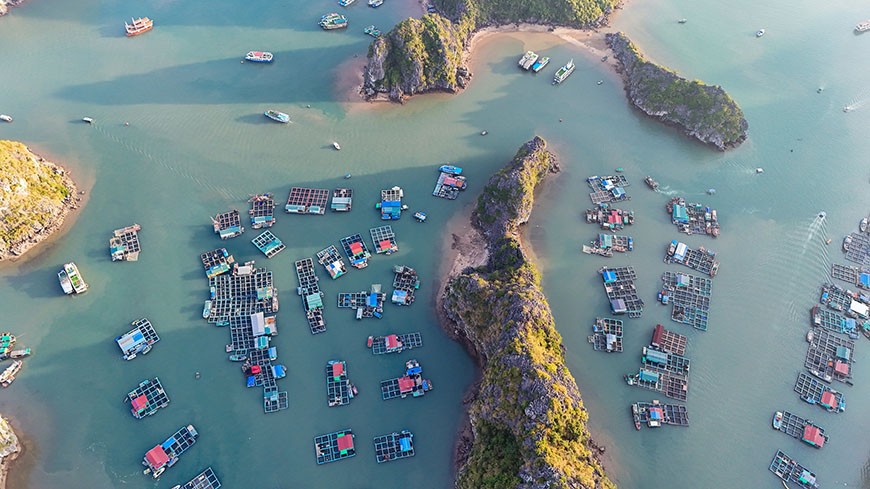 Lan Ha Bay Floating Village
Lan Ha Bay Floating Village
A floating village in Lan Ha Bay. Photo: Mr. Linh’s Adventures.
9. Conclusion: Embark on Your Unforgettable Trekking Adventure with SIXT.VN
Whether you’re a seasoned hiker or a casual walker, Cat Ba promises an unforgettable experience in the heart of breathtaking scenery. What are popular trekking routes in Cat Ba? From the challenging trails to Ngu Lam Peak to the tranquil beauty of Ao Ech, there’s something for everyone. With its varied trails, charming accommodations, and delicious cuisine, Cat Ba has it all. And with SIXT.VN, planning your trip has never been easier.
9.1 How Can SIXT.VN Enhance Your Trekking Experience in Vietnam?
SIXT.VN offers a range of services designed to make your Vietnam trekking adventure seamless and unforgettable:
- Expert Travel Advice: Get personalized recommendations for trekking routes, accommodation, and activities based on your interests and fitness level.
- Convenient Airport Transfers: Start your trip stress-free with reliable and comfortable airport transfer services.
- Hotel Booking Assistance: Find the perfect accommodation to suit your budget and preferences.
- Tour and Activity Bookings: Discover and book exciting tours and activities, including kayaking, caving, and boat trips.
- Flight Booking Services: Secure the best flight deals to Vietnam, saving you time and money.
9.2 What Are Some Popular Cat Ba Tour Packages Offered?
- Cat Ba Adventures 2 days 1 night: A short but sweet adventure exploring the highlights of Cat Ba.
- Cat Ba Trekking & Kayaking 3 days 2 nights: Combine trekking with kayaking for an active and immersive experience.
- Northern frontier adventure to Cat Ba Island 8 days 7 nights: Explore the northern frontier of Vietnam and discover the beauty of Cat Ba Island.
9.3 Ready to Embark on Your Trekking Adventure? Contact SIXT.VN Today!
Don’t hesitate, and set off to discover this natural jewel of Vietnam! Contact SIXT.VN today to start planning your unforgettable trekking adventure in Cat Ba National Park.
Address: 260 Cau Giay, Hanoi, Vietnam
Hotline/Whatsapp: +84 986 244 358
Website: SIXT.VN
10. FAQs: Your Questions About Trekking in Vietnam Answered
10.1 What are popular trekking routes in Vietnam for beginners?
For beginners, popular trekking routes include Cuc Phuong National Park, Bach Ma National Park, and the Ngu Lam Peak trail in Cat Ba National Park. These trails offer manageable distances and elevations, allowing you to enjoy the beauty of Vietnam’s landscapes without strenuous physical exertion. According to Vietnam National Administration of Tourism, these locations are well-maintained and frequently visited, making them safer and more accessible for novice trekkers (Vietnam National Administration of Tourism, 2023).
10.2 What permits or fees are required for trekking in Vietnam?
Trekking in national parks often requires an entrance fee, typically around 40,000 VND per person. Some areas may require permits, especially for overnight treks or restricted zones. It’s best to check with local park authorities or your tour operator for the most up-to-date requirements.
10.3 What should I pack for a trekking trip in Vietnam?
Essential items to pack for a trekking trip in Vietnam include:
- Comfortable hiking boots
- Lightweight, breathable clothing
- Rain gear
- Insect repellent
- Sunscreen
- A hat
- A first-aid kit
- A water bottle or hydration pack
10.4 Are there any health precautions I should take before trekking in Vietnam?
Consult your doctor about necessary vaccinations and malaria prevention. Drink plenty of bottled water to stay hydrated, and be cautious about food hygiene. It’s also wise to carry a basic first-aid kit and be aware of potential hazards like snakes and insects.
10.5 Is it safe to trek independently in Vietnam, or should I join a guided tour?
While independent trekking is possible in some areas, joining a guided tour is recommended, especially for more remote or challenging routes. Guides provide valuable local knowledge, ensure your safety, and can enhance your cultural experience.
10.6 What is the best time of year to trek in the Sapa region?
The best time to trek in Sapa is during the dry season, from March to May and September to November. The weather is generally clear and cool, providing ideal conditions for hiking and stunning views of the rice terraces.
10.7 What are some popular homestay options for trekkers in Vietnam?
Popular homestay options are available in Sapa, Mai Chau, and Cat Ba Island. These homestays offer a chance to experience local culture, enjoy home-cooked meals, and support local communities.
10.8 What is the difficulty level of trekking to Fansipan Peak?
Trekking to Fansipan Peak is considered challenging, requiring a good level of fitness and experience. The ascent involves steep climbs and rocky terrain, but the reward is breathtaking panoramic views from the highest point in Indochina.
10.9 What are some less-crowded trekking destinations in Vietnam?
For less-crowded trekking destinations, consider Pu Luong Nature Reserve, Ba Be National Park, or the trails around Phong Nha-Ke Bang National Park. These areas offer stunning natural beauty and fewer tourists, providing a more tranquil trekking experience.
10.10 How can SIXT.VN help me plan my trekking trip in Vietnam?
SIXT.VN provides comprehensive travel services, including expert travel advice, convenient airport transfers, hotel booking assistance, tour and activity bookings, and flight booking services. Contact us today to plan your unforgettable trekking adventure in Vietnam!



